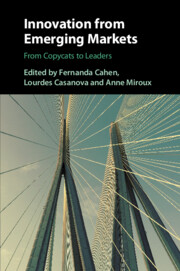Book contents
- Innovation from Emerging Markets
- Innovation from Emerging Markets
- Copyright page
- Contents
- Figures
- Tables
- Boxes
- Contributors
- Foreword
- Acknowledgments
- Introduction
- 1 A Framework for Innovation in Emerging Markets
- Part I Drivers of Innovation in Emerging Markets
- Part II Types of Innovation in Emerging Markets
- Part III Innovation Outcomes in Emerging Markets
- Conclusions
- Index
- References
Part I - Drivers of Innovation in Emerging Markets
Published online by Cambridge University Press: 15 March 2021
- Innovation from Emerging Markets
- Innovation from Emerging Markets
- Copyright page
- Contents
- Figures
- Tables
- Boxes
- Contributors
- Foreword
- Acknowledgments
- Introduction
- 1 A Framework for Innovation in Emerging Markets
- Part I Drivers of Innovation in Emerging Markets
- Part II Types of Innovation in Emerging Markets
- Part III Innovation Outcomes in Emerging Markets
- Conclusions
- Index
- References
Summary

- Type
- Chapter
- Information
- Innovation from Emerging MarketsFrom Copycats to Leaders, pp. 37 - 182Publisher: Cambridge University PressPrint publication year: 2021

